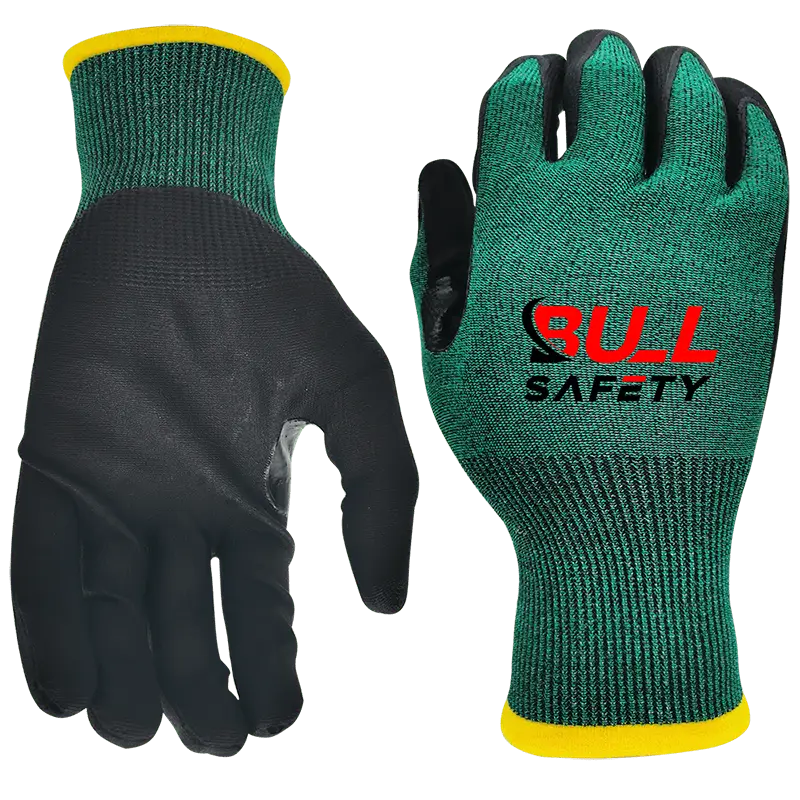
Bullsafety 18gauge A2 4X42B Microfoam Palm Coated Gloves
Microfoam gloves are a type of work gloves with a specialized microfoam nitrile coating, designed for superior grip, breathability1, and dexterity. If you’re looking for gloves that help you handle small parts, tools, and equipment with ease, microfoam gloves[^2] are a great option.
I recommend microfoam gloves because they provide excellent grip, flexibility, and comfort, making them ideal for handling tasks in dry, wet, or oily environments.
Let me walk you through why these gloves might be the right choice for your workplace.
What Are the Main Uses of Microfoam Gloves?
If you’re in an industry where hand protection is essential but you still need flexibility and grip, microfoam gloves are a reliable solution.
Industries where microfoam gloves are commonly used:
| Industry | Common Usage |
|---|---|
| Automotive | Handling greasy parts with precision |
| Construction | Protecting hands while maintaining dexterity |
| Warehousing | Preventing slippage when lifting packages |
| Electronics | Safe handling of delicate components |
| Manufacturing | Operating machinery with better control |
Why Should You Use Microfoam Gloves in These Industries?
- Automotive: Ensures a firm grip on oily components while protecting your hands from minor abrasions.
- Construction: Provides protection against rough surfaces while allowing flexibility for tools and materials.
- Warehousing & Logistics: Helps you handle packages securely to prevent accidents.
- Electronics & Precision Work: Prevents contamination and provides a clean grip on sensitive components.
- Manufacturing: Reduces hand fatigue during repetitive tasks while ensuring durability.
These gloves are also highly breathable, preventing sweat buildup and improving comfort during long work hours.
Are Microfoam Gloves Considered Nitrile-Coated Gloves?
Yes, microfoam gloves are a type of nitrile-coated gloves[^3]. The microfoam coating enhances breathability and grip compared to standard nitrile coatings.
How Are Microfoam Nitrile Gloves Different From Standard Nitrile Gloves?
| Feature | Microfoam Nitrile Gloves | Standard Nitrile Gloves |
|---|---|---|
| Breathability | High, allows airflow | Low, traps heat |
| Grip | Excellent in oily conditions | Moderate, mainly for dry surfaces |
| Dexterity | High flexibility for precision work | Stiffer, less flexible |
| Comfort | Lightweight, reduces fatigue | Can feel thick and heavy |
| Durability | Long-lasting coating | Wears out faster |
Why Should You Choose Microfoam Over Standard Nitrile?
- Better Airflow: Keeps your hands dry and comfortable.
- Enhanced Grip: The textured microfoam layer increases traction.
- Higher Dexterity: Allows you to handle small objects with ease.
- Reduced Fatigue: Lightweight material supports long work hours.
Unlike standard nitrile gloves that feel thick and restrictive, microfoam gloves offer a second-skin feel while maintaining durability and protection.
What Are the Key Advantages of Microfoam Gloves?
Microfoam gloves offer a great balance of comfort, grip, and durability, making them a top choice for professionals like you.
Key Benefits:
| Benefit | Why It Matters |
|---|---|
| Superior Grip | Works well on dry, wet, and oily surfaces |
| High Dexterity | Thin, flexible material allows precise handling |
| Breathability | Prevents sweat buildup for all-day comfort |
| Lightweight | Reduces hand strain and fatigue |
| Durable | Longer lifespan than traditional nitrile gloves |
Why Should You Consider Microfoam Gloves?
- Prevents Hand Fatigue: Comfortable fit allows you to wear them for long hours without discomfort.
- Enhances Workplace Safety: A secure grip reduces the risk of dropping tools or products.
- Cost-Effective: Longer-lasting material saves you money on replacements.
- Versatile Applications: Suitable for various industries and tasks.
Are There Any Limitations?
- Not Chemical-Resistant: Provides minimal protection against strong chemicals.
- Limited Cut Resistance: Not suitable for handling sharp objects.
- Can Absorb Some Liquids: Long-term exposure to certain liquids may reduce effectiveness.
Despite these minor drawbacks, microfoam gloves remain an excellent choice if you need grip, dexterity, and comfort for your daily tasks.
Conclusion
If you’re looking for gloves that offer precision, breathability, and superior grip, microfoam gloves are a great investment. Whether you work in automotive, construction, electronics, or warehousing, these gloves provide the dexterity and protection you need for a productive workday.
I highly recommend microfoam gloves if you want long-lasting comfort, strong grip, and high flexibility to improve workplace safety and efficiency.
Footnotes
-
Discover why breathability in gloves is crucial for comfort ↩



